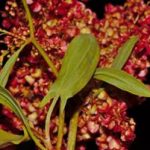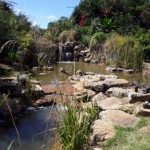TREE LIFE
May 2021
Saturday May 1st There will be a meeting in the Botanic Gardens where there is always something new to see. We will meet in the car park at 0815 for an 0830 start. We hope this walk will only take 1.5 hours.
May 16th 2021. We have been invited by Zia Thomas to visit their beautiful plot at Trafalgar Avenue at 10.00 a.m. You are invited to bring your lunch and picnic.
Due to the Covid-19 pandemic, a Christmas Social was not held in December 2020. However, the last Christmas Social was so poorly attended that a decision was made to hold a Social at some other time during the year away from the rainy season and when not much else was happening – i.e. other Christmas parties. We have thus decided to have the AGM and the Social on the same day. Please see below for details. This promises to be a special occasion.
NOTICE OF THE ANNUAL GENERAL MEETING OF THE TREE SOCIETY
Notice is hereby given that the 71st Annual General Meeting of the Tree Society of Zimbabwe will be held at the Bridgeways Complex, Avondale on Sunday 9th May 2021 at 10.00 am.
Any proposals/resolutions and nominations for office bearers (and any volunteers to be on the Committee) should be forwarded by email to the Secretary Teig Howson at teig.howson@gmail.com by Thursday 6th May if possible, although proposals and nominations will be accepted from the floor.
N.B. The minutes of the 70th AGM held by email last year will be circulated again by email and thus will be taken as read at this years’ AGM. You need to be paid up to vote – you can pay your subscriptions in US$ at the AGM.
AGENDA
- Notice convening the meeting.
- Apologies
- Matters Arising:
- Chairman’s Report
- Treasurer’s Report
- Election of Office Bearers
- Any other business
However, as mentioned above, we will be having the social on the same day, program below:
09: 30 Coffee / Tea and Eats
10:30 AGM
11:00 +- Scavenger Hunt
12:00 +- Braai–ing, socializing and lunch
14:00 Fun Quiz
15:00 Coffee / Tea / Eats and socializing
Please bring some eats to share for tea, and bring your own drinks and glasses. The Society will provide tea and coffee with the necessary cups and saucers etc. In the past the society has provided wine for these occasions, but with the cost of wine as it is at present we are sorry that this cannot be done this year.
We are organizing a braai fire and providing sadza, salads and gravy with something sweet to enjoy thereafter. So bring a packed lunch or something to braai, your plates and cutlery. Braai tools, chairs and tables will be on site, so no need to worry about those things. Come and join the fun and enjoy some happy camaraderie. We hope to see you there.
Unfortunately parking is not permitted near the complex pavilion so parking will be outside the premises. There will be a car guard around who will let you in and give you directions to the pavilion.
NB. The Fun Quiz is really a fun quiz and is very enjoyable as it is done by Bill Clarke.
The Bridgeways Complex, Avondale can be accessed from two totally different directions, but you need to get there via the entrance on Lincoln Road. From Second Street extension, drive past the garage and KFC, past Reps Theatre and continue straight onwards to a T-junction, turn right and the complex will be on your left.
Tree Outing to National Botanical Garden on the 3rd April 2021
This was Easter Saturday and we started off with just seven members but by the time we had finished our numbers had been boosted by a few late comers who had joined us. Present on a bright sunny day were: Dawn Siemers, Meg Coates-Palgrave, Mark Hyde, Jan van Bel, Jim Dryburg, May & Michael Dawes, Peter & Barbara Dean, Ryan Truscott and his daughter Cassia and myself.
We were going to try to identify some Yellowwoods and look at anything else that caught the eye, so we headed off towards the Herbarium to see these trees which as far as I know are nowhere else within the gardens. First tree to be seen was a Tibouchina granulosa which is looking pretty old and not in good condition. This tree has number 33 meaning that it is one of the 45 numbered plants to be seen in the gardens as per the 20 year old map which is sometimes available at the entrance gate. A few of these numbered trees no longer exist – no doubt died of old age or disease.
Nearby was a Pandanus utilis whose common name is screwpine. Why screwpine, I don’t know! The leaves are growing in a very tight spiral but are long, nothing like a pine. Perhaps it’s the fruit which look spiky like a cone but these are very spherical. The fruit can be eaten after it has been cooked, the nut can be eaten raw or cooked.
Nearby, at the corner of the Herbarium building were some Podocarpus sp. Yellowwoods. After much debate, it was thought that there were a couple of Podocarpus henkelii and a Podocarpus madagascariensis. The problem with the National Botanical Garden is that trees can be indigenous or exotic and because even some of the indigenous trees natural habitat is not on the highveld, they don’t always look typical and so are sometimes difficult to identify. We saw a few more yellowwoods nearby which we also failed to identify and then saw a rather large tree we hadn’t looked at before which resembled a Pterocarpus rotundifolius but the leaflets were too round. I took a couple of leaves to compare them with the Pterocarpus brennanii foliage.
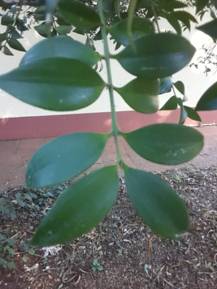
Podocarpus nagi. Photo: Tony Alegria
The Japanese yellowwood Podocarpus nagi has completely different leaves, broad in comparison to the other yellowwoods and without a midrib.
Nearby were the other Washingtonia palms which were not the robusta, possibly the W. filifera.
We then had a look at the four exotic fig trees which are fairly common in Harare: Ficus benjamina. Weeping fig; Ficus lyrata. Fiddle-leaved fig; Ficus religiosa. Sacred fig and Ficus elastica. Rubber fig. Whilst in the area we looked at an indigenous fig, Ficus sansibarica. Knobbly fig, which had many figs growing on the branches – totally different to the other four fig trees we had just seen!
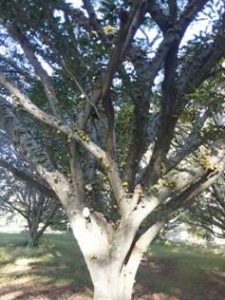
Ficus sansibarica. Photo: Tony Alegria
We compared the leaves I had taken earlier on with those of the Pterocarpus brennanii and found them similar but a bit more glossy. The P. brennanii had obvious stipules whilst those from the other tree did not have …. So a bit of a mystree.
Incidentally the Pterocarpus brennanii tree had a label which read Pterocarpus rotundifolius which it definitely was not – just another tree which had been mislabeled.
We didn’t really succeed in identifying the yellowwoods but nonetheless we saw many plants and trees and had a great morning.
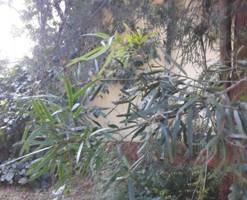
Podocarpus madgascarienses. Photo: Tony Alegr
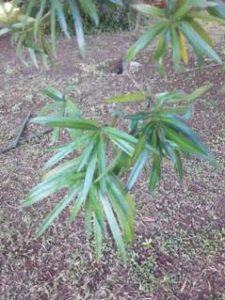
Podocarpus henkelli. Photo: Tony Alegria
-Tony Alegria
GARDENIAS AND GUM TREES: A CAUTIONARY TALE
My family and I have just returned from a trip to Lake Mutirikwi, in Masvingo.
We stayed at a camp not far from the Pokoteke Gorge, which slices through the Beza Range. Those hills, running east to west, are thickly blanketed with Mountain acacias, Brachystegia glaucescens.
Standing outside our tent was another tree that looked familiar to me.
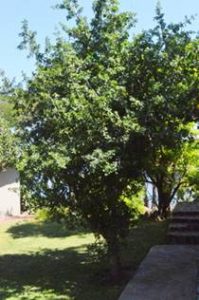
The Common Gardenia tree. Photo: Ryan Truscott
At first glance I thought it was a Dovyalis, but this one had no thorns.
Spiders’ nests were woven among its branches and dark green leaves, and a dangling orange wing was all that remained of a butterfly caught in one of the spider’s webs.
After a brief search I found two lonely fruits: they looked like miniature pumpkins topped with a tuft of hair. But they told me what I needed to know: that these were the distinctive fruits of the Common gardenia, Gardenia volkensii, subsp. spatulifolia.
There was no sign of the tree’s waxy, heavily-scented flowers. They will only emerge in September.
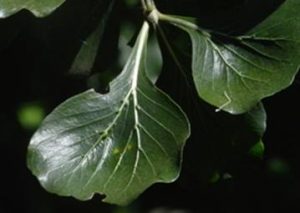
The leaves are broadly obovate. Photo: Ryan Truscott
Experts say their pale colour and strong perfume are probably designed to attract moths, and that where these trees grow in farming districts, cattle love to eat the fruit and browse the young trees into strange shapes.
The specific name — volkensii– is after the German naturalist Georg-Ludvig August Volkens who did his plant collecting in East Africa in the early 1890s.
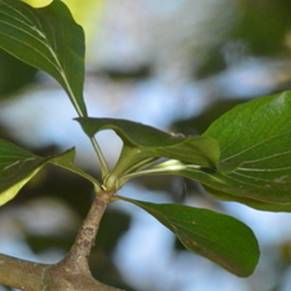
The lateral spurs resemble thorns. Photo: Ryan Truscott
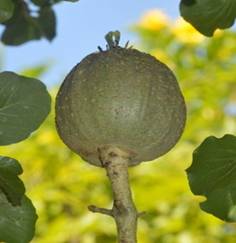
Distinctive Gardenia fruit. Photo: Ryan Truscott
The leaves, which have flattened ends, emerge mostly in threes from spikes. These spikes (in fact they’re dwarf lateral branches) give the impression that the tree is armed with thorns.
Having satisfied myself as to the identity of this tree, I spent the next few crystal-clear days hiking in the heavily wooded hills behind the camp, cruising on the bright blue lake and watching peregrine falcons screeching high among the crags of the Pokoteke Gorge. Bliss.
But on our last night, storm clouds reared up on the horizon, and a fierce wind buffeted the camp.
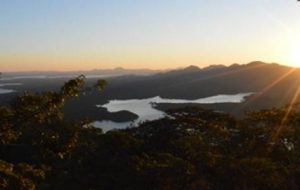
Sun sets behind the Beza Range. Photo: Ryan Truscott
A line of eucalyptus trees, planted as a windbreak, creaked in protest.
I tried to recall something a forester once told me about eucalyptus trees but got distracted with packing up our belongings ahead of an early-morning departure.
Later, from the shelter of our tent, I heard the piercing sound of our car alarm above the roar of the wind: a dead branch had fallen from one of the eucalyptus trees and shattered our rear windscreen into thousands of tiny pieces.
That’s when I remembered what the forester had told me all those years ago.
“Don’t camp in a eucalyptus forest,” he had warned. “The branches can snap off in high winds. The heavier end makes the branch spiral downwards like a spear. It’ll rip through your tent and skewer you like a piece of chicken.”
His sons and I were on our way to camp in Odzani, a forestry area north of Mutare. We were going to see a family of wattled cranes breeding on a wetland there. That weekend, heeding his advice, we camped beneath pine trees.
The morning after the Mutirikwi storm, as the camp owner skillfully patched up my shattered windscreen with a thick sheet of plastic, he lamented my rotten luck.
“Gum trees are only supposed to shed their branches in August and September,” he said.
I didn’t tell him about my plan to return in September. I’d like to once again hear the cries of the fish eagles ringing out across the lake, see the sun set behind the Beza range and hopefully inhale the heady scent of gardenia flowers.
But this time I’ll be sure not to park under a gum tree.
-Ryan Truscott
Visiting the gardens at 131 Enterprise Rd, Harare, Sunday 28th March 2021
It was the second tree outing after the year-long forced lockdown. The venue was of special interest to us because most of the trees there were planted by Ann Sinclair, committee member of the Tree Society. Our last 3 outings were at the Nat. Bot. Gardens. Now we were looking forward to something unknown, ready to wonder about and identify the trees and plants. A group of 15 people, including all our botanical gurus, had assembled at the entrance of what looked like a park. Ann welcomed us and gave a small informative introduction. She planted most of the trees about 20 years ago, when she was residing there.
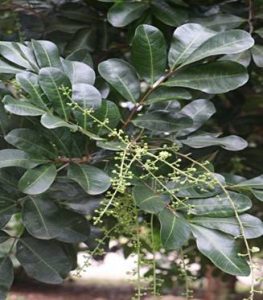
Cupaniopsis anacardioides, Photo: Mark Hyde
On entering the place you immediately get overwhelmed by the variety of species. Now we were walking and getting a feel of a 20 year old garden. On driving in, the first tree already asked for a closer inspection. Ekebergia capensis, Cape ash, not a common garden tree and seen more in lower lying areas. The next one was more of the type we usually encounter in gardens: Syzygium guineense subspecies afromontane. Its fruits gone, it didn’t keep us long. A tree that for me resembled much like the Boer bean Schotia was named by Ann as her Israeli tree, once a gift from that country. She told us that it has white flowers and yellow fruits. Mark took a leaf for further research. Two days later he informed me that it was Cupaniopsis anacardioides, tuckeroo or beach tamarind from Australia.
Next was a Podocarpus. Usually it takes time to agree on the species. About 5 metres high and with long lanceolate leaves, we all were in agreement that it must be Podocarpus henkelii, Henkel’s yellowwood. The next tree looked like a Callistemon but this one didn’t have the weeping branches. It was a Calliandra surinamensis, pink powder puff. An impressive Clausena anisata, horsewood was pointed out by Ann. Some of us went to smell the leaves with the characteristic foul scent. An Oak tree, not our usual find, it had serrated leaves and was named by Mark as Quercus acutissima, sawtooth oak, from Asia. Now and then Mark identified some of the small weeds, shrubs and flowers. One of them was a Hypericum species. An Erythrina abyssinica, red-hot-poker tree, showed its 20 year size. Apodytes dimidiata, white pear, looked older and bigger than those ones we’ve seen on rare occasions. An Acacia with mostly straight spines also had a few curved ones as well. After some inspection and counting leaflets it was hesitantly labeled as Acacia nilotica subsp. Kraussiana.
Another interesting tree that made us stationary looked like Azanza, but with almost round leaves. It could be a Thespesia, tulip tree. Next day it was confirmed to be another Malvaceae member: Hibiscus tiliaceus, coast hibiscus. A Bridelia micrantha, mitzeerie, looked its 20 year age. A Mundulea sericea, cork bush, had grown so high it was difficult to see the leaves.
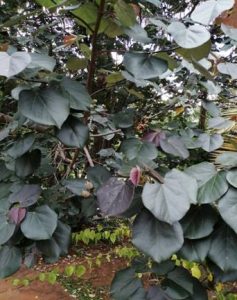
Hibiscus tiliaceus. Photo J. Van Bel
A smaller tree was Vepris undulata, now renamed V. lanceolata, white ironwood. Acacia nigrescens, knob-thorn, with its remarkable trunk. Combretum paniculatum, burning bush combretum, had very big leaves and was entangled and growing through an Oncoba spinosa, fried egg flower, which had some nice baby rattle fruits hanging. We saw a Celtis africana. White stinkwood and a Tecomaria capensis, Cape honeysuckle. A few Naartjes trees, citrus nobilis, with plenty of fruits. We looked at the winged petiole and the tri-foliate leaves.
We passed ficus elastica, Lagerstroemia indica, Indian pride, and Dracaena steudneri. Then we came to a Tabernaemontana with its twin pods that were green-brown and smooth. Probably Tabernaemontana ventricosa, small-fruited toad tree. Craibia brevicaudata had reached a good size for a 20 year old. The Phytolacca dioica, belhambra, one of those trees you see regularly in gardens and that cause often problems with their prolific growth. Here it clearly showed its horizontal roots and the reason why it shouldn’t be planted close to a house or wall.
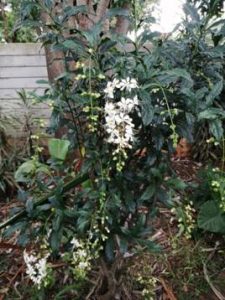
Bridal veil Photo by Jan van Bel
The Schotia brachypetala, weeping boer-bean, that I had expected to see here when I wrongly labeled the Cupaniopsis, was at last there. Couldn’t be missing in a tree lover garden. Acokanthera oppositifolia, common poison-bush, was there. Searsia lancea, willow searsia, and the Sapindus saponaria, so common in Harare and that other foreign Bocconia, tree poppy, with its nicely contrasting grey leaves, also present. An Ulmus parvifolia, Chinese elm, had plenty of seeds hanging. Lonchocarpus sericeus was identified, a rain tree from tropical west Africa which has silky hairy leaves.
Getting back to the gate, and having been overwhelmed by all this green I had overlooked a Stenocarpus sinuatus, firewheel tree, which I could have vowed for to find it here. Also a Combretum hereroense, mouse-ear combretum had escaped me. It was time to leave but people were still ambling around as there was so much to see. A showy shrub attracted us from some distance. It had white cascading panicles of flowers. It didn’t take long for Mark to name it Clerodendrum nutans, bridal veil, another alien from India and Nepal, but too beautiful to leave out the picture here.
-Jan van Bel
SUBSCRIPTIONS FOR 2021/2022
Our new financial year commenced on 1st April and subscriptions for the year ending 31st March 2022 are now due and payable.
TONY ALEGRIA, CHAIRMAN


